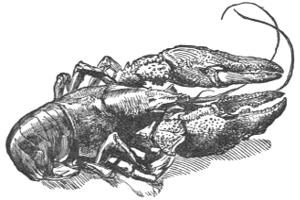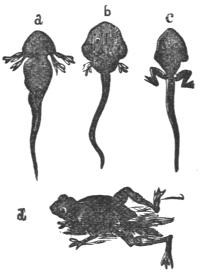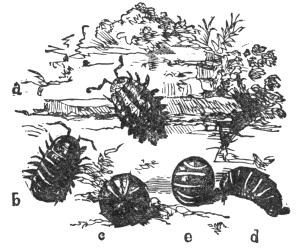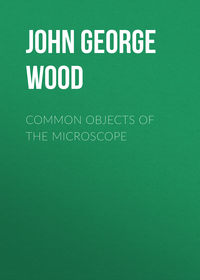 полная версия
полная версияThe Common Objects of the Country
Very delicate food are these lamperns, quite as good as the lampreys themselves, whose excellence is reported to have cost England one of her kings; yet I never knew but one person who would eat them, and very few who would even touch them, they also being called poisonous.
In Germany they know better, and not only eat the lamperns themselves, but, packing them up in company with vinegar, bay leaves, and spices, export them as an article of sale.
The solitary sensible individual of whom I have made mention was truly a wise man. He used to offer the young urchins of the neighbourhood a reward for bringing lamperns, at the rate of a halfpenny per wisketful.
A wisket, I may observe, is a kind of shallow basket, made of very broad strips of willow; and a wisket filled with lamperns would be a tolerable load for a boy.
So, for the sum of one halfpenny, that philosopher was furnished with provisions for a day or more.
Really, the prejudice against the lampern is most singular. Even near London, when lamperns lived in vast numbers in the Thames, they were only used as bait, being sold for that purpose to the Dutch fishermen. In one season, four hundred thousand of these creatures have been sold merely for bait for cod-fish and turbot.
The scientific name for the lampreys is “Petromyzon,” a word signifying “stone-sucker”. The name is rightly applied; for when the lampern wishes to remain still in one place, it applies its mouth to a stone, sticks tightly to it by suction, and there remains firmly at anchor, and defying the power of the stream. In favourable spots, thousands of these fish may be seen together, quite blackening the bottom of the stream with their numbers. They seem specially to affect shallow mountain streams; and, in spite of the rapid current, wriggle their devious way up the stream with great rapidity. When they are not quite pleased with the spot on which they settle down for the time, they scoop it out to their minds in a very short time. This task is accomplished by means of the sucker-like mouth. If a stone is placed in a position that incommodes them, they affix their mouths to it, and drag it away down the stream. In this way they will remove stones which are apparently beyond the power of so small a creature. By perseverance they thus scoop out small hollows, about eighteen inches long and a foot wide, in which they lie in groups so thick that I have more than once mistaken them for dark logs lying in the stream, and was only undeceived by the waving of the multitudinous tails. Year after year the lamperns followed the same course, and chose the same positions, so that we could at any time tell where these creatures would be found by the thousand, where they would be found singly, and where none would be seen at all.
The general thickness of this creature is that of a large pencil, but it varies according to the individual. The length is from one foot to fifteen inches or so.
There is a much smaller species of lampern called the Pride, Sand-pride, or Mud Lamprey, which is not more than half the length of the lampern, and only about the thickness of an ordinary quill. This creature has not the power of affixing itself like the lampern, on account of the construction of its mouth.
Having now taken a hasty glance at the vertebrated animals, we pass to those who have no bones at all, and whose skeleton, so to speak, is carried outside. Our representation of aquatic crustacea, as such creatures are called, will be the Cray-fish and the Water-Shrimp.

THE CRAY-FISH.
Every one knows the Cray-fish, because it is so like a lobster, turning red when boiled in the same way. This red colour is brought out by heat even if applied by placing the shell before a fire, and spirits of wine has the same effect. The last fact I learned from experience, and was very sorry that it was a fact, for the red shell quite spoiled the appearance of a dissected cray-fish that was wanted to look nice in a museum.
Being very delicate food, and, in my opinion, much better than the native lobster, they are much sought after at the proper season, and are sold generally at the rate of half-a-crown for one hundred and twenty.
There are many modes of catching them, which may be practised indifferently. There are the “wheels,” for example, being wicker baskets made on the wire mouse-trap principle, which the cray-fish enters and cannot get out again. Also, there is a mode of fishing for them with circular nets baited with a piece of meat. A number of these nets are laid at intervals along the river bank, and after a while are suddenly pulled out of the water, bringing with them the cray-fish that were devouring the meat.
But the most interesting and exciting mode of cray-fish catching is by getting into the water, and pulling them out of their holes.
Cray-fish take to themselves certain nooks and crannies, formed by the roots of willows or other trees that grow on the bank; and they not unfrequently take possession of holes which have been scooped by the water-rat. The hand is thrust into every crevice that can be detected, and if there is a cray-fish, its presence is made known by the sharp thorny points of the head,—for the cray-fish always lies in the hole with its head towards the entrance.
The business is, then, to draw the creature out of its stronghold without being bitten—a matter of no small difficulty. If the hole is small, and the cray-fish large, I always used to draw it forward by the antennæ or horns, and then seize it across the back, so that its claws were useless.
The power of the claws is extraordinary, considering the size of the creature that bears them. They will often pinch so hard as to bring blood; and when they have once secured a firm hold, they do not easily become loosened. Still, the risk of a bite constitutes one of the chief charms of the chase.
The legitimate mode of disposing of the cray-fish, when taken, is to put them into the hat, and the hat on the head; but they stick their claws into the head so continually, and pull the hair so hard, that only people of tough skin can endure them.
Sometimes, when the bed of the river is stony, the cray-fish live among and under the stones, and then they are difficult of capture; for with one flap of their tail they can shoot through the water to a great distance, and quite out of reach.
It is not unfrequent to find a cray-fish with one large claw and the other very small. The same circumstance may be noted in lobsters. The reason of this peculiarity is, that the claw has been injured, generally in single combat; for the cray-fish are terrible fighters, and the mutilated limb has been cast off. Most wonderfully is this managed.
The blood-vessels of the crustaceans are necessarily so formed, that if wounded, they cannot easily heal; and if there were no provision against accidents, the creature might soon bleed to death.
But when a limb, say one of the claws, is wounded the limb is thrown off—not at the injured spot, but at the joint immediately above. The space exposed at the joints is very small in comparison with that of an entire claw; and as the amputation takes place at a spot where there is a soft membrane, it speedily closes. In process of time, a new limb begins to sprout, and takes the place of the member that had been thrown off.
The eyes of the cray-fish are set on footstalks, so as to be turned in any direction, and they can also be partially drawn back, if threatened by danger. If the eye is examined through a magnifying glass of tolerable power, it will be seen that it is not a single eye, but a compound organ, containing a great number of separate eyes, arranged in a wonderful order. As, however, a description of an insect’s eye will be given at a succeeding page, we at present pass over this organ.
At the proper season of the year, the female cray-fish may be seen laden with a large mass of eggs, which she carries about with her, and by the movement of the false legs that are arranged in double rows on the under surface of the tail, keeps them supplied with fresh streams of water. In process of time, the eggs are hatched; but very few, in comparison, reach maturity. Even the mother herself is apt to eat her own young, when they have set themselves free from her control. I have known this to take place when we were trying to breed cray-fish in a tank. Only one attained to any size, and even that was not so large as a house-fly when we took it from the water.

FRESH-WATER SHRIMP.

TADPOLES AND YOUNG FROG.
The fresh-water Shrimp may generally be found in plenty in any running stream. Its appearance and habits very much resemble the Sandhopper, a little creature that every one must have seen who has walked on a sandy sea-shore. Like the cray-fish, this little creature carries its eggs about until they are hatched. It is a carnivorous animal, and is one of the numerous scavengers of the water, without whose help every stream would soon become putrid and loathsome.

WOODLOUSE, ARMADILLO, AND PILL MILLEPEDE.
Certain species of crustacea inhabit the land; two of which are well known under the titles of Woodlouse and Armadillo. They belong to the class of crustaceans called “Isopod,” or equal-footed, because the legs are all of the same nature; whereas, in the other crustacean, some legs are used for walking, and others are turned into claws, &c. The woodlouse is to be found in myriads under the scaly bark of trees, under stones, and, in fact, in almost every crevice. It feeds mostly on decayed vegetable matters, but also eats animal substances, and vegetables that are not decayed. Some gardeners hold the woodlouse in great horror, and say that nothing is so hard or so bitter that a woodlouse will not eat it. If the bark is removed from an ancient willow tree, any number of these creatures may be discovered, in every stage of existence, scuttling about in great fear at the unwelcome light, and sticking close to the wood in hopes that they may not be seen. Dried coats of the woodlouse may be also seen, empty and bleached to an ivory whiteness. They are night-feeders; and, although they can run fast enough if disturbed, walk very deliberately when only employed in feeding.
The Armadillo-woodlouse is very curious, and easily recognised from its habit of rolling itself into a round ball when alarmed, just like the quadruped armadillo. Its habits are much the same as those of the common woodlouse. Formerly the armadillo was used in medicine, being swallowed as a pill in its rolled-up state. I have seen a drawer half full of these creatures, all dry and rolled up, ready to be swallowed.
On the preceding cut are two armadillo-like animals, much resembling each other, but belonging to different orders. Fig. a is the Woodlouse; b, the Pill Millepede, walking; c, the same rolled up; d is the true Armadillo, walking; and e, the same creature rolled up.
One of the minute crustaceans, the common Cyclops, is shown on plate J, fig. 14. Its length is about the fourteenth of an inch; and though it is so small, the female Cyclops may easily be detected in the water by the curious egg-sacs.
CHAPTER V
A SHORT ESSAY ON LEGS—TAKING A WALK—BRITISH FAKIRS—INSECT LIFE—DEVELOPMENT—THE TIGER MOTH—GROWTH OF THE CATERPILLAR—HOW TO DISSECT INSECTS—PLAN OF CATERPILLAR ANATOMY—SILK ORGANS—ORGANS OF RESPIRATION—SPIRACLES AND THEIR USE—WONDERS OF NATURE—THE CHRYSALIS—SCIENTIFIC LANGUAGE.
As, in common with many other animals, mankind are furnished with legs, and the power to move them, it is universally acknowledged that those limbs ought to be put to their proper use. But while men agree respecting the importance of the members alluded to, they differ greatly in the mode of employing them.
To the tailor, for example, legs are chiefly valuable as cushions, whereon to lay his cloth. For the jockey, the same members form a bifurcated or pronged apparatus, by the help of which he sticks on a horse. The legs of the acrobat are mostly employed to show the extent of ill-treatment to which the hip-joint can be subjected without suffering permanent dislocation. The dancer values his leg solely on account of the “light fantastic toe” which it carries at its extremity. The turner sees that two legs are absolutely necessary to mankind—i.e., one to stand upon, and the other to make a wheel run round. The surgeon views legs—on other people—as objects affording facilities for amputation. The boxer professionally regards his legs as “pins,” upon which the striking apparatus is kept off the ground. The soldier’s opinion of his legs is modified according to the temperament of the individual, and the position of the enemy. Some people employ their legs in continually mounting the same stairs, and never getting any higher; while others use those limbs in continually pacing the same path and never going any farther.
And of all these modes of employing the legs, the last, which is called “taking a walk,” is the dreariest and least excusable.
For, in the preceding cases, the owners of the legs gain their living, or at all events their life, by such employment of those members; and in the case of the interminable stairs, the individual is not acting by his own free will. But it does seem wonderful that a being possessed of intellectual powers should fancy himself to be the possessor of a right leg and a left one, merely that the right should mechanically pass the left so many thousand times daily and in its turn be passed by the left; while the sentient being above was occupied in exactly the same manner as if both legs were at rest, snugly tucked under a table.
Sad to relate, such is the general method of taking recreation.
A man who has been over-tasking his brain all the early part of the day, rises corporeally from his work at a certain time, places his hat above his brain, buttons his coat underneath it, and sallies forth to take a walk.
Whatever subject he may be working upon he takes with him, and on that subject he concentrates his attention. Supposing him to be a mathematician, and that the prevalent idea in his mind is to prove that △ A B C = (∠ D E F + ∠ G H I). He takes one final look at his Euclid while drawing on his gloves, and sets off with A B C before his eyes.
As he walks along, he sees nothing but A B C, hears nothing but D E F, feels nothing but G H I, and thinks of nothing but the connection of all three.
An hour has passed away and he re-enters his room without any very definite recollection of the manner in which he got there. He has mechanically paced to a certain point, mechanically stopped and turned round, mechanically retraced his steps, and mechanically come back again.
He has not the least recollection of anything that happened during his walk; he don’t know whether the sky was blue or cloudy, whether there was any wind, nor would he venture to say decidedly whether it was night or day. He does recollect seeing a tree on a hill and a spire in a valley, because, together with himself, they formed an angle that illustrated the proportions of the triangle A B C; but whether the tree had leaves or not he could not tell. But he is happy in the consciousness of having performed his duty;—he has taken a walk, he has been for a “constitutional”.
O deluded and misguided individual! The walking powers are meant to carry yourself—not only your corporeal body—into other scenes, to give a fresh current to your thoughts, and to give your brain an airing as well as your nose. The mind requires variety in its food, as does the body; and to obtain that change of nutriment is the proper object of taking a walk.
That a rational being can condemn himself to walk three miles along a turnpike road, and three miles back again, at one uniform pace, his eyes directed straight ahead, and his thoughts at home with his books, seems incredible to ordinary personages.
Yet, such British fakirs may be seen daily in all weathers, on the roads leading from university towns, going at the rate of four miles per hour, their hats tilted towards the back of their heads, their bodies inclining forward at an angle of eighty degrees, their lips muttering polysyllabic language, and their eyes as beaming as those of a boiled cod-fish.
Now the real use of taking a walk is to get away from one’s self, and to change the current of the thoughts for a while, by changing the locality of the individual.
In order so to do, he should cast his senses abroad instead of concentrating them all within himself; and from sky, air, water, and earth draw a new succession of images wherewith to relieve the monotony within. There are various modes of attaining this object; and each man will follow that mode which most accords with his own character.
For example, if he is an astronomer, he will look to the heavenly bodies; if a geologist, his eyes will be directed to the earth; if a botanist, his mind seeks employment among the vegetable productions; if a meteorologist, the wind’s temperature and atmospheric phenomena will claim his attention; if an entomologist, he will find recreation in watching the phases of insect life, and so on.
It is evident enough that to treat of all these subjects would render necessary a volume that numbered its pages by thousands, and its volumes by at least tens; and therefore, in a work of this nature, it must be sufficient to lay particular stress on one portion, to treat slightly of others, and to leave many entirely untouched. And that portion on which I shall lay the chief stress is that which is brought more constantly before the eye and ear than any other, namely, the entomological department.
As, when approaching cities, the “busy hum of men” is the first indication that meets the ear, so in the country the busy hum of insects is, next to the song of the birds, the sound that gives strongest evidence of a life untrammelled by the artificial rules of society.
Not only do insects make their presence known to the ear, but they also address themselves to the eye. Their forms may be seen flitting through the air, running upon the ground, or making their abode on the various examples of vegetable life. Comparatively small as insects are, they are of vast importance collectively; and there is hardly a leaf of a tree, a blade of grass, or a square inch of ground, where we may not trace the work of some insect. Nearly all strange and curious objects that are noticed by observant eyes in the woods or fields are caused by the action of insects, and are often the insects themselves, in one or other of the phases of their varied life. Certain examples of insect life, and its effects, will now be given. No particular order will be observed, no long scientific terms will be used, and every creature that is mentioned will be so common that it may be found almost in every field.
The first creature that we will notice is that caterpillar which is so abundantly found at several seasons of the spring and summer, and, from the long hairy skin in which it is enveloped, goes by the popular name of the “Woolly Bear!” A figure of this creature may be seen in plate B, fig. 5 a. This creature is the larva of the common Tiger-moth, which is represented on the same plate, fig. 5.
It will be necessary to pause here a little, before proceeding to the description and histories of the various insects, because in the course of description certain terms must be used, which must be explained in order to make the description intelligible.
In the first place, let it be laid down as a definite rule, that
INSECTS NEVER GROWMany people fancy that a little fly is only little because it is young, and that it will grow up in process of time to be as big as a blue-bottle. Now this idea is entirely wrong; for when an insect has once attained to its winged state, it grows no more. All the growing, and most part of the eating, is done in its previous states of life; and, indeed, there are many insects, such as the silkworm-moth, which do not eat at all from the time that they assume the chrysalis state to the time when they die.
It is a universal rule in nature, that nothing comes to its perfection at once, but has to pass through a series of changes, which if carefully examined can mostly be reduced to three in number. Sometimes these changes glide imperceptibly into each other, but mostly each stage of progress is marked clearly and distinctly. Such is the case with the insect of which we are now considering; and when we have examined the development of the Tiger-moth through its phases of existence, we have the key to the remainder of the insects.
After an insect has left the egg, and entered upon the world as an individual being, it has to pass through three stages, which are called larva, pupa, and imago.
The word “larva,” in Latin, signifies “a mask,” and this word is used because the insect is at that time “masked,” so to speak, under a covering quite different from that which it will finally assume. In the present instance, the Tiger-moth is so effectually masked under the Woolly Bear, that no one who was ignorant of the fact would imagine two creatures so dissimilar to have any connection with each other.
Throughout this work the word “larva” will be always understood to signify the first of the three states of insect life, whether it be a “caterpillar,” a “grub,” or a “worm”.
In its next stage the insect becomes a “pupa,” which word means a “mummy,” or a body wrapped in swaddling clothes. This name is employed because in very many insects the pupa is quite still, is shut up without the power of escape, and looks altogether much like a mummy, wrapped round in folds of cloth. In the moths and butterflies the insect in this stage is called a “chrysalis,” or “aurelia,” both words having the same import, the first Greek and the other Latin, both derived from a word meaning “gold”. Several butterflies—that of the common cabbage butterfly, for example—take a beautiful golden tinge on their pupal garments, and from these individual instances the golden title has been universally bestowed.
The last, and perfected state, is called the “imago,” or image, because now each individual is an image and representative of the entire species.
The Woolly Bear, then, is the larva of the Tiger-moth; and if any inquiring reader would like to keep the creature, and watch it through its stages, he will find it an interesting occupation. There is less difficulty than with most insects, for the creature is very hardy, and the plant on which it mostly feeds is exceedingly common.
Generally, the Woolly Bear is found feeding on the common blind nettle, but it may often be detected at some distance from its food, getting over the ground at a great rate, and reminding the spectator of the porcupine. In this case it is usually seeking for a retired spot, whither it resorts for the purpose of passing the helpless period of pupa-hood.
If it is captured on such an occasion, there will be little trouble in feeding, as it will generally refuse food altogether, and, betaking itself to a quiet corner, prepare for its next stage of existence.
If taken at an earlier period of its life, it feeds greedily on the nettle above-mentioned, and the amount of nutriment which one caterpillar will consume is perfectly astounding. I once had nearly four hundred of them all alive at the same time, and they used to be furnished with nettles by the armful. Of course so large a number is not necessary for ordinary purposes; but this regiment was required for the purpose of watching the development and anatomy of the creature through its entire life.
As the skins of caterpillars are not capable of growth, and the creature itself grows with singular rapidity, it is evident that the skins themselves must be changed, as is the case with many other animals of a higher class, such as the snakes, newts, &c.
For this purpose the skin of the caterpillar splits along the back of the neck, and by degrees the creature emerges, soft, moist, and helpless. A very short time suffices for the hardening of the new envelope; and as the caterpillar has been obliged to fast for a day or two, previously to changing the skin, it sets to work to make up for lost time, and does make up effectually.






